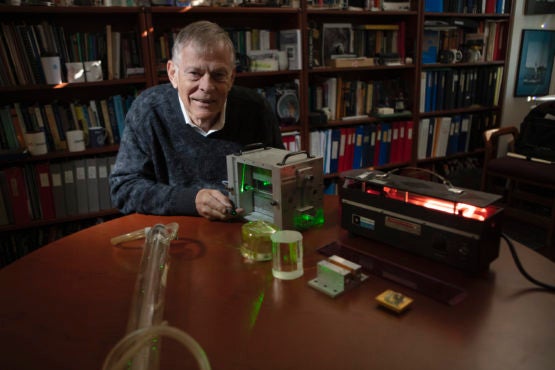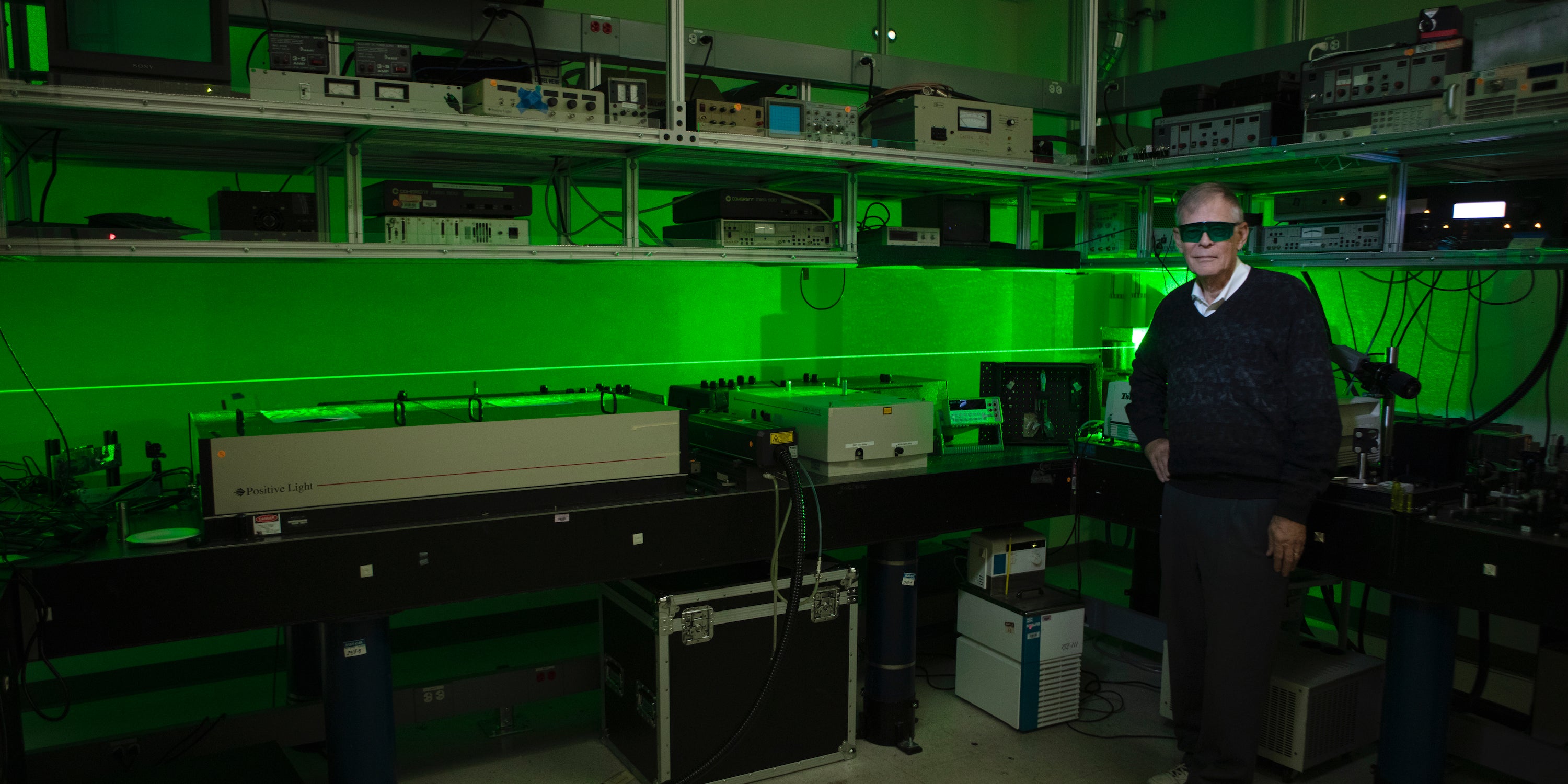Stanford physicist recalls life-changing first glimpse of a laser
Physicist Robert Byer worked on lasers when they were still just an interesting technology, never imagining their myriad modern uses or how they would affect his life.
Robert Byer was 22 years old when he first saw the light that changed his life.

Robert Byer developed the first visible, tunable red laser by routing a green laser through a nonlinear crystal (Image credit: Misha Bruk)
One summer morning in 1964, Byer drove the hour from Berkeley down to Mountain View for a job interview at a California company called Spectra Physics. He walked in to find an empty lobby but could hear clapping and cheering in the back of the building. After politely waiting for several minutes, he followed the commotion to a darkened room filled with men whose jubilant faces were illuminated by a rod of red-orange light that seemed to float above an instrument-strewn table.
Byer, who is now professor of applied physics and photon science at Stanford’s School of Humanities and Sciences, had walked in on history. The assembled physicists and engineers had just switched on the first ionized-gas laser that could be seen with the naked eye and they were basking in the glow of their accomplishment. Other visible-light lasers existed at the time, but they were weak and dim by comparison.
Lasers – tuned, or “coherent,” light waves that can be focused into tight beams and adjusted to specific colors – had been invented a few years earlier, but Byer had never laid eyes on one until that moment. He always imagined they would resemble the beam of a strong flashlight. But the mercury ion laser he glimpsed that day, with its preternatural brightness and steady radiance, had a heft and a presence unlike any light Byer had ever seen.
Roughly an inch thick and about two feet long, the laser also sparkled, glimmering like wet sand on a sunny day. Byer later learned that this speckled effect is a calling card of lasers, created when the crests and troughs of closely packed light waves crash into one another, creating interference.
That captivating light, and the palpable excitement of the scientists Byer met that day, altered the course of his life. Recently graduated from UC Berkeley, he was slated to be married in a few months and already had a job lined up in Pasadena in Southern California. But those plans were now in doubt because Byer accepted a position at Spectra Physics that very day.
Byer is slim, with neatly combed gray hair, a gentle, gravelly voice and keen eyes. He is logical and exacting when it comes to his work, but with regard to that momentous decision he made in his twenties, he says it just felt right. “All I had was a gut feeling,” he said. “I know there’s an expectation for scientists to take the rationality that’s in science and apply it to their personal relations, but that’s not what happens.”
Byer called his fiancé a few days later and delicately asked if she would consider transferring from UCLA to UC Berkeley to finish her undergraduate studies. “Not on your life,” she said.
Evi Guzsella did eventually agree, however, and Byer became the 13th employee at Spectra Physics. To make it up to her, Byer saved his earnings for a year and took his new wife on a two-month long European camping tour.
“In life, you make thousands of decisions, and almost always, the decisions that really matter, the ones that really count, are the ones you have the least information about.”
—Robert Byer
Professor of Applied Physics and of Photon Science
Lasers are ubiquitous today. Modern society could not function without them. Lasers enable self-driving cars to sense their environments and surgeons to correct vision. A typical smartphone contains hundreds of them. The world’s digital and internet communications require the conversion of relatively short-range cellular and Wi-Fi signals into laser pulses that must be pushed through fiber optic cables to distant cell towers and web servers.
But when Byer began working on lasers in 1964, they were so new that a use for them hadn’t been invented yet. The first widespread application of lasers was to speed up grocery checkout by using a red helium-neon laser to scan unique barcodes on products. The technology behind barcode checkout was developed as part of a joint project between the National Cash Register Corporation and Spectra Physics.
By then, Byer had already left the company to enroll as a graduate student at Stanford University, studying under professor Stephen Harris to develop lasers with different colors and properties. For his thesis, Byer developed the first visible, tunable red laser by routing a green laser through a nonlinear crystal.
Byer also helped develop the quietest, most stable laser in the world, called the diode-pumped YAG laser. YAG lasers are today found in everything from communications satellites to green handheld laser pointers, which Byer co-developed with two of his graduate students and cites as one of his favorite inventions (he had joined Stanford in 1969). YAG lasers also form the main beams of the gravitational wave-detecting instrument, LIGO, which in 2015 achieved the most precise measurement ever made by humans when its antenna detected the tenuous spacetime fluctuations generated by two colliding black holes 1.3 billion light-years away.
The Spectra Physics laser that enchanted Byer 55 years ago sits in a clear case just outside his office, the bulky instrument an occasional reminder for Byer of how far the field – and he himself – have come.
“In life, you make thousands of decisions, and almost always, the decisions that really matter, the ones that really count, are the ones you have the least information about,” Byer said. “We didn’t know as we worked to develop lasers where they would lead. They shaped the future only after they happened.”
Stanford Report is exploring the stories behind the curiosity and excitement that drives foundational discoveries in the arts, humanities, social sciences and sciences.
Byer is also the William R. Kenan, Jr. Professor of Applied Physics, a professor of photon science at SLAC National Accelerator Laboratory and a member of Stanford Bio-X.


